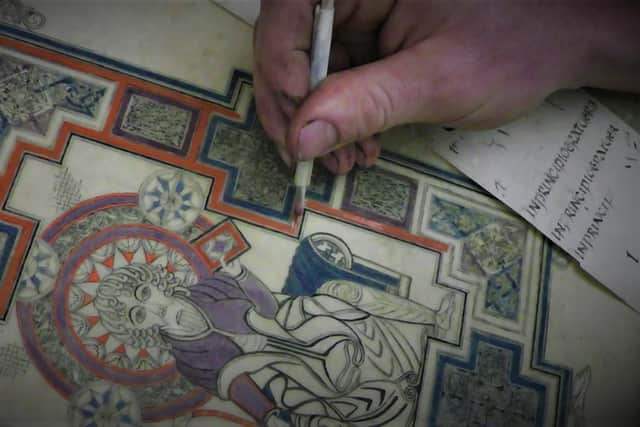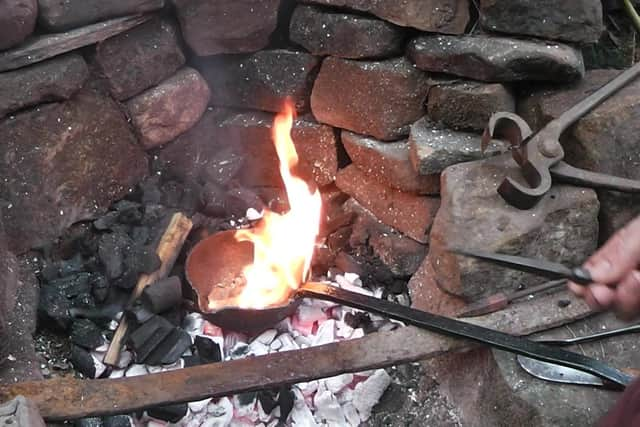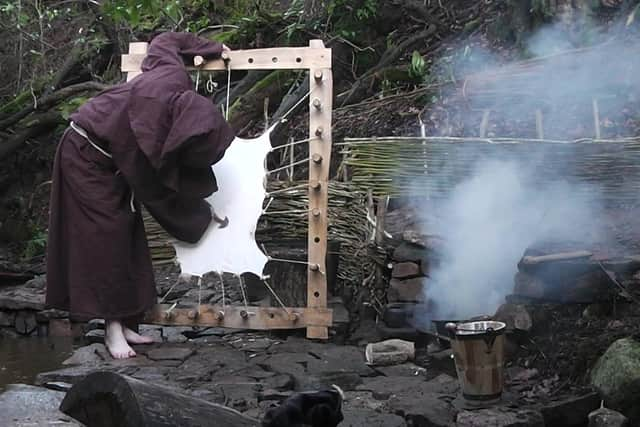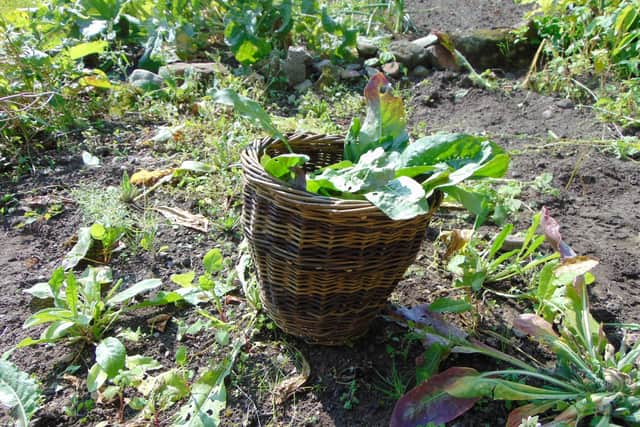Book of Kells to be recreated in the Highlands to prove treasured manuscript was made by Pictish monks in the far north
Artist Thomas Keyes, from Cromarty in the Black Isle, aims to build on a growing body of evidence stating the religious manuscript could have been made not at Iona Abbey or other key religious centres, but at Portmahomack in Easter Ross.
As he immerses himself in early book-making processes for the task, Keyes will gather a selection of plants and seaweeds from Highland woods and shorelines to make the pigments found in the Book of Kells and use techniques deployed during the Pictish era to create his replica.
Advertisement
Hide AdAdvertisement
Hide AdWritten around 800AD, the illuminated religious manuscript, which contains four gospels of the New Testament, is renowned for its extravagant and complex illustrations, which feature Celtic patterns, Christian iconography and depictions of humans, animals and mythical beasts.
Keyes, 46, said he was "90 per cent sure” the Book of Kells was made at Portmahamock, the site of a Pcitish abbey and book-making workshop, following seven to eight years of research and experimentation.
He said: "I am 100 per cent sure it could have been made there. You can’t exclude it.”
To help prove the monks at Portmahomack had the right ingredients available locally to make the Book of Kells, woad will be grown in Keyes’s garden to make the vivid blues found in the manuscript. The black ink will be derived from oak bark and gum from cherry trees.
Meanwhile, the red pigments will be made from “old Roman lead” bought on eBay. It will be burned with horse manure to create a white mass that will be burned again at high temperature to give it colour. It will then be mixed with egg white before being applied to the parchment.


Some of the tools known to have been used by monks at Portmahomack will be replicated with the skin of a young cow, which will be prepared to make the parchment, coming from a nearby farm.
As the artist immerses himself in the life of a Pictish monk, he will snack on gathered hazels as he works.
The hundreds of tiny pockmarks found on the surface of the parchments are central to Keyes’s strong belief the Book of Kells was produced at Portmahomack.
Advertisement
Hide AdAdvertisement
Hide AdHe said he believed the little holes were created by a particular ingredient developed by the Portmahomack monks to wash the cow hide given they were nowhere near a source of lime, which was traditionally used in the process.


Keyes said: “At Portmahomack, they would gather seaweed and burn it for potash to create the alkaline solution to soak the skins in.
"This is much less efficient than burning lime if you are trying to make a solution of equivalent strength. So I believe that at Portmahomack they used the potash solution to grow a culture of bacteria that partially rotted the hides, removing the unwanted tissue and leaving the pure collagen which becomes the parchment.
"This bacteria causes little pockmarks on the parchment where the bacteria has eaten it away. You can see these little marks on the Book of Kells."
Other major monasteries cited as potential production sites all have locally available limestone, which makes the use of the bacteria much less likely, the artist said.


Keyes said: “If you look at Northumbria, which has a number of manuscripts attributed to the area, the difference in the parchment is clear. The Lindisfarne Gospels hardly has a single hole in it and is a consistent pale tone throughout which is characteristic of lime-based parchment.
“The Kells has hundreds of holes and a great range of tones, a feature of bacterially produced parchment."
Tradition has it that monks at St Columba’s monastery on Iona – or possibly St Columba himself – created the book. When Viking raids threatened Iona, the monks are thought to have escaped to Kells, in Meath, Ireland.
Advertisement
Hide AdAdvertisement
Hide AdKeyes, who is raising more than £8,000 for the project, said: “At Iona, the main contender for the source of the Book of Kells, limestone is found on the nearby island of Inch Kenneth.
"Kells in Ireland is unlikely as it is 50 miles from the sea, so excluding seaweed and it sits right on top of limestone. It almost excludes the Book of Kells being Irish in origin.”
He added: "By the process of elimination, the case can be made for Portmahomack.”


The remains of a Pictish monastery and a workshop that produced books and fine metalworks sits at the site of the Church of St Colman in Portmahomack, with the church building now home to the Tarbat Discovery Centre museum.
Finds made at the site include a stylus used for writing, a book clasp and fragments of high quality Pictish sculpture.
"You could not hope for a better range of finds to support the theory that a manuscript of Kells quality could have been made at this site,” Keyes said.
He will recreate folio 27v from the Book of Kells, which features the four evangelist symbols within an ornate border. A former graffiti artist, Keyes was introduced to the “letter arts” aged 12, with the skills he acquired through endless practice and development of muscle memory helping to equip him for his Book of Kells challenge.
He described the monks who made the Book of Kells as an “intellectual elite” that changed how people “thought in words”. He said: “The Book of Kells is really only the tip of the iceberg. These monks were an intellectual elite that guided western Europe into the literate age. We still rely on many of their innovations."
To support the project, visit www.kickstarter.com.
Comments
Want to join the conversation? Please or to comment on this article.